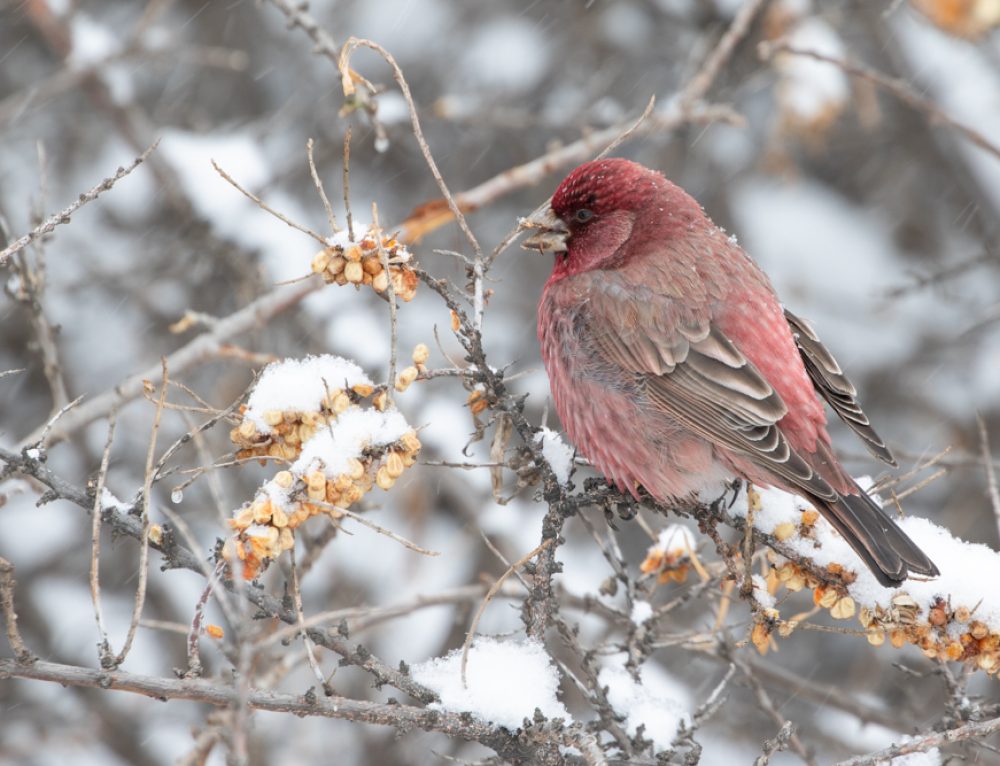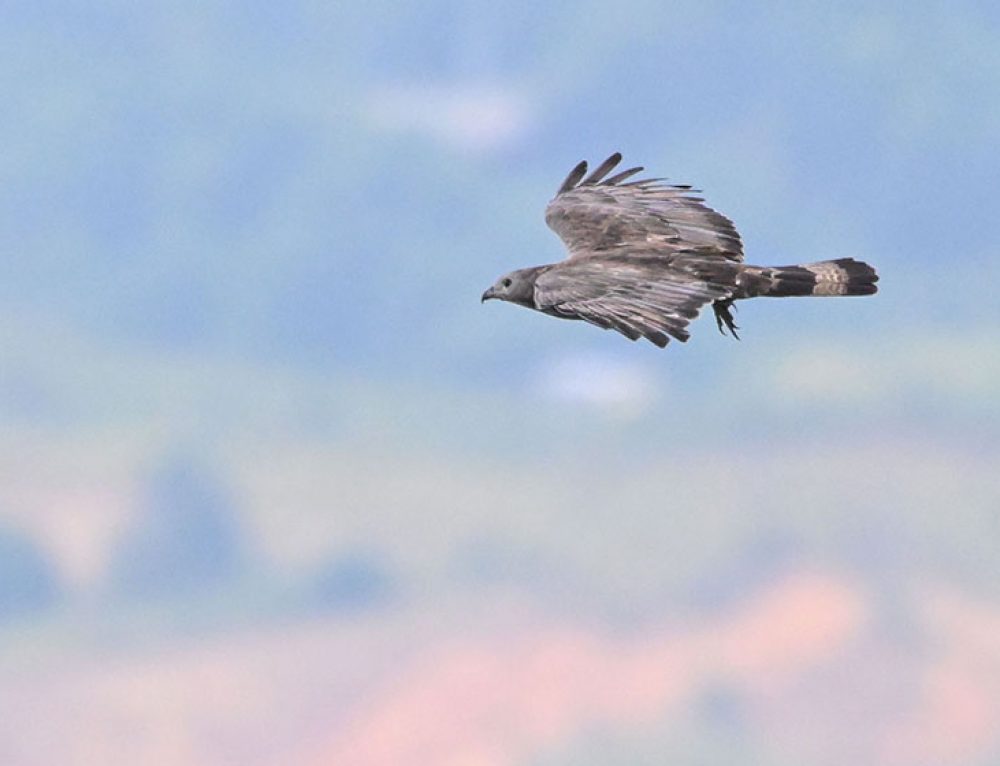No other than Lord Byron, the well-traveled English poet, believed that Armenia ‘must ever be one of the most interesting on the globe’. Although these remarks referred to old history and language of Armenia, also from a birder’s perspective the poet’s enthusiasm can well be comprehended: Armenia, the smallest of the three South Caucasus countries, offers an amazing variety of landscapes, habitats and bird species! Much of Armenia is dominated by the Armenian Highlands. Its northern part is often referred to as the ‘Lesser Caucasus’, which itself is part of the vast Anatolian-Iranian fold mountains, so it is entirely logical that most of the country’s territory is located in the range from one to three thousand meters, but all the elevated birding sites are accessible by vehicle. Armenia is a landlocked country, however, the absence of a seacoast does not prevent it from offering some of the best birding in the region. This largely intact and sparsely inhabited country is home to more than half of Europe’s regularly occurring species, many of which are represented here by subspecies of Western and Central Asian origin that are extremely rare or hard to find elsewhere in our region, including a few purely Caucasian specialities. Our bargain birdwatching tour covers all the ornithological hotspots and key sites of the country, focusing on the most sought-after birds of Armenia, with a lot of additional bonuses and some of the most likely larger mammals. All visited regions are, of course, safe to visit and far from any conflict zones.
Classic Armenia
A ten-day birdwatching tour to Armenia
3 – 14 June 2026
Target birds
| Caspian Snowcock | 00 | Radde’s Accentor | 00 | Menetries’s Warbler | 00 | Rosy Starling | 00 | Black-headed Bunting |
| Chukar Partridge | 00 | Rufous-tailed Scrub Robin | 00 | Paddyfield Warbler | 00 | Rock Sparrow | 00 | Bearded Vulture |
| Dalmatian Pelican | 00 | White-throated Robin | 00 | Upcher’s Warbler | 00 | Pale Rockfinch | 00 | Griffon Vulture |
| Pygmy Cormorant | 00 | Blue Rock Thrush | 00 | Eastern Olivaceous Warbler | 00 | White-winged Snowfinch | 00 | Cinereous Vulture |
| Armenian Gull | 00 | Common Rock Thrush | 00 | Mountain Chiffchaff | 00 | Red-fronted Serin | 00 | Egyptian Vulture |
| White-tailed Lapwing | 00 | Isabelline Wheatear | 00 | Green Warbler | 00 | Trumpeter Finch | 00 | Golden Eagle |
| Blue-cheeked Bee-eater | 00 | Eastern Black-eared Wheatear | 00 | Red-breasted Flycatcher | 00 | Asian Crimson-winged Finch | 00 | Long-legged Buzzard |
| Syrian Woodpecker | 00 | Finsch’s Wheatear | 00 | Semicollared Flycatcher | 00 | Desert Finch | 00 | Lesser Kestrel |
| Horned Lark | 00 | Red-tailed Wheatear | 00 | Western Rock Nuthatch | 00 | Twite | 00 | Levant Sparrowhawk |
| Bimaculated Lark | 00 | Eastern Orphean Warbler | 00 | Eastern Rock Nuthatch | 00 | Grey-necked Bunting | 00 | Montagu’s Harrier |
| 0 | 0 | 0 | 0 | 0 | 0 | 0 | 0 | 0 |

Overview
The first day of our Armenian voyage will take us to Armash Fishfarm, a complex of ponds located in the vast expanses of the Araks River valley, above which the Greater and Lesser Ararat arise. Views of these mighty biblical mountains, where, according to legend, Noah’s ark found its rest, are revealed in tenfold beauty from a nearby mountain gorge, where we’ll have an exciting rendezvous with several very interesting bird species in the afternoon of the same day, but more on that later.
 Back in Soviet times, when these fish ponds were created, the authors of the project probably could not even imagine that after some time they would turn into a real bird paradise. Having barely entered the area, Blue-cheeked Bee-eaters will be all around us. Their bright colors can only be rivaled by the numerous Rosy Starlings and European Rollers. Another favorite of many, which is impossible to overlook when visiting Armash, is Bearded Reedling. In general, Armash is one of the most attractive places for interesting passerines, and especially for various warblers. Here we find Turkestan Short-toed Larks, which are generally rather scarce in the rest of Armenia. Moustached, Paddyfield and Menetries’s Warblers are easily seen, as well as many sought-after aquatic bird species such as the White-tailed Lapwing. This elegant shorebird is one of the local attractions, without which no visit takes place. The same goes for Pygmy Cormorants, White-headed, and Marbled Ducks. As for gulls and terns, the Armenian Gull is the dominant species on Armash, as practical in all of Armenia, but here one can also experience a large number of Slender-billed Gulls and White-winged Terns. However, on Armash, we do not intend to waste much time on gulls and terns, as in a week we have planned a visit to a lake home to one of the largest known colonies of Armenian Gulls.
Back in Soviet times, when these fish ponds were created, the authors of the project probably could not even imagine that after some time they would turn into a real bird paradise. Having barely entered the area, Blue-cheeked Bee-eaters will be all around us. Their bright colors can only be rivaled by the numerous Rosy Starlings and European Rollers. Another favorite of many, which is impossible to overlook when visiting Armash, is Bearded Reedling. In general, Armash is one of the most attractive places for interesting passerines, and especially for various warblers. Here we find Turkestan Short-toed Larks, which are generally rather scarce in the rest of Armenia. Moustached, Paddyfield and Menetries’s Warblers are easily seen, as well as many sought-after aquatic bird species such as the White-tailed Lapwing. This elegant shorebird is one of the local attractions, without which no visit takes place. The same goes for Pygmy Cormorants, White-headed, and Marbled Ducks. As for gulls and terns, the Armenian Gull is the dominant species on Armash, as practical in all of Armenia, but here one can also experience a large number of Slender-billed Gulls and White-winged Terns. However, on Armash, we do not intend to waste much time on gulls and terns, as in a week we have planned a visit to a lake home to one of the largest known colonies of Armenian Gulls.
 The above-mentioned nearby gorge is one of the few places in Armenia where Red-tailed Wheatears can be found. Southern Armenia is generally characterized by arid habitats with sparsely vegetated hills, barren gorges, and rocky cliffs typically inhabited by Isabelline, Eastern Black-eared and Finsch’s Wheatears. The other specialities of these habitats are White-throated Robin and Rufous-tailed Scrub Robin; the latter species we’ll enjoy watching repeatedly also the following days. Here, any bush and scrub might hold another Eastern Olivaceous, Upcher’s or Eastern Orphean Warblers, and from any pinnacle of the slopes a Blue Rock Thrush or Chukar Partridge might call. Small water holes attract many birds, including such topnotch species as Trumpeter, Asian Crimson-winged and Desert Finches, as well as Black-headed, Ortolan and Grey-necked Buntings. Rock Sparrows and Red-fronted Serins are not uncommon here, and at these watering places we will also have good opportunities to observe Pale Rockfinches. However, not only feathered beauties will capture our attention and we’ll visit several famous medieval monasteries, being at the same time home to a very rich bird and animal life. In one of these places, called Noravank Monastery, once again we can expect to see both Western and Eastern Rock Nuthatches, Syrian Woodpeckers and many more species.
The above-mentioned nearby gorge is one of the few places in Armenia where Red-tailed Wheatears can be found. Southern Armenia is generally characterized by arid habitats with sparsely vegetated hills, barren gorges, and rocky cliffs typically inhabited by Isabelline, Eastern Black-eared and Finsch’s Wheatears. The other specialities of these habitats are White-throated Robin and Rufous-tailed Scrub Robin; the latter species we’ll enjoy watching repeatedly also the following days. Here, any bush and scrub might hold another Eastern Olivaceous, Upcher’s or Eastern Orphean Warblers, and from any pinnacle of the slopes a Blue Rock Thrush or Chukar Partridge might call. Small water holes attract many birds, including such topnotch species as Trumpeter, Asian Crimson-winged and Desert Finches, as well as Black-headed, Ortolan and Grey-necked Buntings. Rock Sparrows and Red-fronted Serins are not uncommon here, and at these watering places we will also have good opportunities to observe Pale Rockfinches. However, not only feathered beauties will capture our attention and we’ll visit several famous medieval monasteries, being at the same time home to a very rich bird and animal life. In one of these places, called Noravank Monastery, once again we can expect to see both Western and Eastern Rock Nuthatches, Syrian Woodpeckers and many more species.
 One early morning will be dedicated to a visit to the mountains of Yeghegnadzor offering excellent opportunities to enjoy one of the most impressive species of the region: the Caspian Snowcock! These magnificent birds share their habitat with Brown Bears and Bezoar Goats, while the meadows around the lookout point are strewn with various rare and endemic orchids. From here, having made the way through the historical Silk Road and the legendary mountain gate of the Selim Pass, we find ourselves on the shores of the alpine Lake Sevan, the largest sweetwater lake in the entire Caucasus region, home to numerous Armenian Gulls. An old-grown forest of the Dilijan National Park to the north of the lake harbors several further target species such as Mountain Chiffchaffs, Green Warblers, Red-breasted and Semicollared Flycatchers, Ehrenberg’s Redstarts (samamisicus subspecies of a Common Redstart), and several species of woodpeckers, including Middle Spotted.
One early morning will be dedicated to a visit to the mountains of Yeghegnadzor offering excellent opportunities to enjoy one of the most impressive species of the region: the Caspian Snowcock! These magnificent birds share their habitat with Brown Bears and Bezoar Goats, while the meadows around the lookout point are strewn with various rare and endemic orchids. From here, having made the way through the historical Silk Road and the legendary mountain gate of the Selim Pass, we find ourselves on the shores of the alpine Lake Sevan, the largest sweetwater lake in the entire Caucasus region, home to numerous Armenian Gulls. An old-grown forest of the Dilijan National Park to the north of the lake harbors several further target species such as Mountain Chiffchaffs, Green Warblers, Red-breasted and Semicollared Flycatchers, Ehrenberg’s Redstarts (samamisicus subspecies of a Common Redstart), and several species of woodpeckers, including Middle Spotted.
 On the penultimate day, we’ll explore another protected alpine lake, close to the border triangle with Georgia and Turkey, in the northwestern corner of the country. This lake is part of a conglomerate of volcanically formed high-altitude water bodies of the ‘Lesser Caucasus’. This lake provides good opportunities to observe Ruddy Shelducks, both Dalmatian and Great White Pelicans, Black Storks, Glossy Ibises, feldegg subspecies of Western Yellow Wagtails and Citrine Wagtails. With some luck we’ll see the globally threatened ‘Caucasian Common Crane’ (archibaldi subspecies of a Common Crane) which struggles to survive in this region. The closing part of our journey across Armenia will take place at Mount Aragats, the highest peak of the country and a place not chosen at random. Thanks to the road leading to the astronomical observatory, we’ll reach the altitude of 3200 meters, where we’ll look for Bimaculated Larks in the alpine steppe and Radde’s Accentors at some old ruins nearby. Black Redstarts, Common Rock Thrushes, Common Rosefinches and Ortolan Buntings are also abundant here, while wet places along streams are best to look for magna subspecies of a Bluethroat. Even higher up, close to the snow line, we’ll meet typical alpine species, such as Red-billed Choughs, Horned Larks, Ring Ouzels, White-winged Snowfinches, Alpine Accentors and Twites.
On the penultimate day, we’ll explore another protected alpine lake, close to the border triangle with Georgia and Turkey, in the northwestern corner of the country. This lake is part of a conglomerate of volcanically formed high-altitude water bodies of the ‘Lesser Caucasus’. This lake provides good opportunities to observe Ruddy Shelducks, both Dalmatian and Great White Pelicans, Black Storks, Glossy Ibises, feldegg subspecies of Western Yellow Wagtails and Citrine Wagtails. With some luck we’ll see the globally threatened ‘Caucasian Common Crane’ (archibaldi subspecies of a Common Crane) which struggles to survive in this region. The closing part of our journey across Armenia will take place at Mount Aragats, the highest peak of the country and a place not chosen at random. Thanks to the road leading to the astronomical observatory, we’ll reach the altitude of 3200 meters, where we’ll look for Bimaculated Larks in the alpine steppe and Radde’s Accentors at some old ruins nearby. Black Redstarts, Common Rock Thrushes, Common Rosefinches and Ortolan Buntings are also abundant here, while wet places along streams are best to look for magna subspecies of a Bluethroat. Even higher up, close to the snow line, we’ll meet typical alpine species, such as Red-billed Choughs, Horned Larks, Ring Ouzels, White-winged Snowfinches, Alpine Accentors and Twites.
 Armenia is rich in raptors. Any forest, even city parks, offer us potential opportunities to see Levant Sparrowhawk, while Cinereous and Egyptian Vultures are very commonly observed in most of the dry mountain regions. At Mount Aragats encounters with Golden Eagles are almost inevitable, and Griffon and Bearded Vultures can hardly be overlooked while soaring over the summer mountain pastures, where dense herds of sheep, led by Kurdish nomads, provide them with plenty of food. Almost all wetlands hold Montague’s Harriers, and for excellent views on Lesser Kestrels, we will specifically visit a colony. Short-toed, Booted, and Lesser Spotted Eagles, Northern Goshawk, and Long-legged Buzzard will be regular sights during our trip, and with some luck we may even enjoy a local pair of the feldeggii subspecies of a Lanner Falcon in Caucasus Wildlife Refuge protected area.
Armenia is rich in raptors. Any forest, even city parks, offer us potential opportunities to see Levant Sparrowhawk, while Cinereous and Egyptian Vultures are very commonly observed in most of the dry mountain regions. At Mount Aragats encounters with Golden Eagles are almost inevitable, and Griffon and Bearded Vultures can hardly be overlooked while soaring over the summer mountain pastures, where dense herds of sheep, led by Kurdish nomads, provide them with plenty of food. Almost all wetlands hold Montague’s Harriers, and for excellent views on Lesser Kestrels, we will specifically visit a colony. Short-toed, Booted, and Lesser Spotted Eagles, Northern Goshawk, and Long-legged Buzzard will be regular sights during our trip, and with some luck we may even enjoy a local pair of the feldeggii subspecies of a Lanner Falcon in Caucasus Wildlife Refuge protected area.
For more information about this tour, please send us an email at info@birdingcaucasus.com
Dates of the next tour: 1 – 12 June 2027
You can also get acquainted with our trip reports for previous years:
- Trip Report – June 2024 (Belgian Group)
- Trip Report – June 2024
Photo credits
- Blue-cheeked bee-eater (homepage) by Daniel Kuehler
- Blue-cheeked bee-eater (tour header) by Daniel Kuehler
- Radde’s Accentor (tour header) by Ilya Ukolov
- Desert Finch (tour header) by Ilya Ukolov
- White-throated Robin (tour header) by Ilya Ukolov
- Menetries’s Warbler (tour overview) by Richard Tyler
- Rufous-tailed Scrub Robin (tour overview) by Alexander Rukhaia
- Semicollared Flycatcher (tour overview) by Daniel Kuehler
- White-winged Snowfinch (tour overview) by Alexander Rukhaia
- Cinereous Vulture (tour overview) by Alexander Rukhaia
#birdingcaucasus #caucasusbirding #birdsofcaucasus #birdingarmenia #birdwatchinginarmenia #birdsofarmenia





